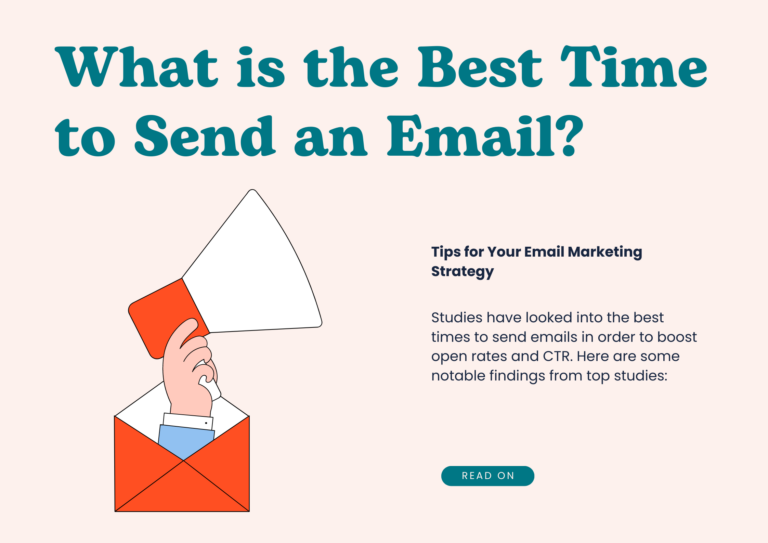The best time to send email is between 9 AM and 11 AM on Tuesday, Wednesday, or Thursday. This is when most people are active, checking their inbox, and have time to engage with content. Emails sent during these hours often get higher open and click-through rates. Mid-morning works well because recipients have cleared out overnight emails and are ready to focus. Avoid Mondays, when inboxes are flooded, and Fridays, when attention shifts to the weekend. Testing different times for your audience can also help improve results, as behavior may vary by industry and recipient type.
Best Time to Send Email for Higher Opens & Clicks
Understanding Email Marketing Metrics
Let us talk about the important metrics in email marketing before getting into the optimal times to send emails:
Open Rate: The proportion of email recipients that click through to read the message.
CTR: It is the proportion of email recipients who click on links in the message.
Conversion Rate: The proportion of recipients who complete a desired action, like buying something or completing a form.
Bounce Rate: The proportion of emails that were unsuccessful in being delivered.
Rate of Unsubscribe: The proportion of recipients who remove themselves from your email list.

Research on the Best Time to Send Marketing Emails
Studies have looked into the best times to send emails in order to boost open rates and CTR. Here are some notable findings from top studies:
-
The Best Times of Week
Research indicates that specific days of the week typically have greater CTRs and open rates. For instance, a MailChimp study discovered that sending emails on Tuesdays and Thursdays typically produces better results. Due to its early workweek and increased likelihood of inbox checks, Tuesday is a popular day. Thursday is particularly productive because it is almost the end of the workweek, but before the weekend, when email engagement tends to decline.
-
Best Times of the Day
Email open rates are also significantly influenced by the time of day. GetResponse found that early morning (between 6:00 and 9:00 AM) or early afternoon (between 1:00 and 3:00 PM) is the best time to send email. This time coincides with the times that most people check their emails, which are either during lunch breaks or first thing in the morning.
-
Industry-Specific Timing
The timing can change based on the sector. According to a Campaign Monitor study, for example, B2B emails function best during regular business hours, but B2C emails receive higher levels of engagement on the weekends and in the evenings. When deciding when to send emails, it is critical to take into account the habits and daily schedules of your target audience.
Tips for Determining the Ideal Time to Send Email Marketing
As insightful as studies can be, it is important to keep your industry and target audience in mind. You can use the following steps to determine when it is ideal to send marketing emails:
-
Be Aware of Your Audience
Recognize the habits, inclinations, and daily schedule of your audience. Think about variables like location, age, gender, and sector. You can use this information to determine when email engagement is most likely among your audience.
-
Experiment with A/B Testing
Emails are sent at various times during A/B testing to see which performs better. Evaluate various days of the week and hours of the day to find patterns in CTR and open rates. Determine the best send times by analyzing the data.
-
Monitor Engagement Metrics
Track engagement metrics such as CTR, open rates, and others with email marketing analytics. Pay attention to how these metrics alter depending on the day and time that emails are sent. You can use this information to improve your email marketing strategy.
-
Segment Your Email List
Sort your email list according to attributes such as region, age, and previous interaction. This makes it possible for you to send targeted emails during the peak engagement periods for particular segments. For instance, modify the time at which you send emails if you have clients who live in different time zones.
Email Optimization to Increase Subscriber List Growth More Quickly
It takes more than just knowing when to send emails to expand your subscriber list. Here are some more pointers to help you maximize your email campaigns:
-
Write Headlines That Grab Attention
The first thing recipients see is your subject line. Make it compelling, concise, and relevant to encourage recipients to open the email.
-
Make Emails Personalized
Personalization boosts interest. Use their names when addressing them and personalize emails according to their interests and actions.
-
Provide Value to Subscribers
To keep subscribers on your list longer, provide them with insightful articles, special deals, or helpful information. Your email subscribers are more likely to interact and spread the word when they find value in what you are sending.
-
Use Clear Calls to Action
A call to action (CTA) that is obvious and instructs recipients on what to do next should be included in your email. A compelling call to action (CTA) can increase conversion rates, whether the action is clicking a link, making a purchase, or registering for an event.
-
Monitor and Adapt
Keep an eye on your email marketing metrics regularly to determine what is and is not working. To make your email campaigns better over time, modify your plan of action in light of your findings.
Understanding the best time to send email necessitates combining specific experimentation with insights from leading studies. You can determine the ideal times to send emails for your company by knowing who your audience is, running A/B tests, and looking at engagement data. Additionally, you can increase subscriber list growth, engagement, and conversions by putting email marketing best practices into practice. Remember, email marketing is a dynamic field, so stay updated on industry trends and adapt your strategy as needed.
